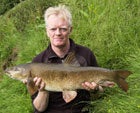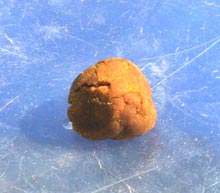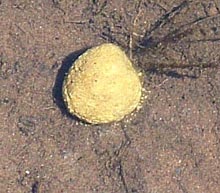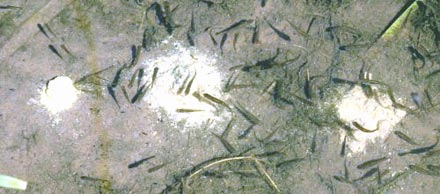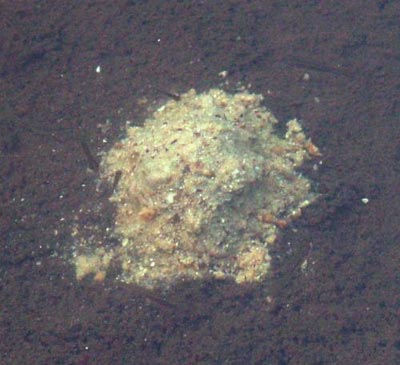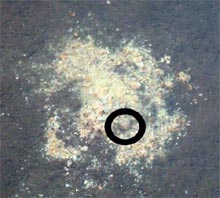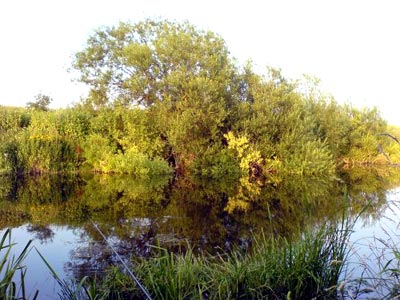| SEAN MEEGHAN | |
Sean is a 50 year old engineer, originally from St Helens in Merseyside, but has lived for the last 22 years in Bradford in West Yorkshire. He classes himself as a general specialist angler, but his main summer species is barbel, with winters being devoted to pike, barbel and the occasional chub session. Perch, trout, tench and roach are targeted as the fancy takes him. Sean has been a member of the Wharfedale Specimen Group for the last 16 years which has enabled him to learn from some of the finest barbel Anglers in the North of England. |
Fishing the Yorkshire Rivers for Barbel Part 2 – Moving into the DeepsIT’S NOW LATE July. The never-ending hot spell is taking its toll, but I can still muster the enthusiasm for an evening’s fishing. Besides, the 50 Mile trip to the Swale is a pleasure with the air conditioning turned up high!I pull into the car park at about 4 o’clock on a Friday afternoon and see Paul, a guy I know, climbing over the stile and disappearing across the field. I follow Paul down to the river and find he has set up, upstream of the nettle patch swim. Mick Wood has a theory that once they are pressured, the barbel will move rapidly through the nettle patch swim and feed in the slightly less exposed water upstream. He’s expounded this theory to Paul who is keen to give it a go. Paul is relatively new to barbel fishing and he’s keen to see barbel feeding. I crawl down to the nettle patch and feed a handful of pellets. Soon some of the resident fish are moving into the swim and cautiously investigating the pellets. I call Paul down and we watch the swim for a while. I point out how a nervous barbel will often sit just above the feed then drop down and take a few pellets from the very top of the swim. This puts the barbel in an ideal position to see any line entering the water, and emphasises the importance of keeping the line above your lead, as close to the bottom as possible. I believe that most line bites are caused by behaviour such as this as the fish catches the line above the lead and spooks. I watch the swim for about half an hour, but no big fish visit it. I decide to put a little feed in another swim and then return to the nettle patch. Now I’ve spent a bit of time since my last visit thinking about presentation. You may remember that in my last piece I described how I used a small PVA bag of pellets to create a ‘hot spot’ of feed in my swim. This is a common strategy and I do worry that barbel may soon wise up to it. So I’ve decided to use a paste wrap instead. I spent a very useful blank session on the Nidd looking at how pastes break down in the water and reached some useful conclusions, which I’m going to apply today. The first thing I noticed is that a paste that appears dark out of the water, is often nothing of the sort when submerged. The two pictures below show what I mean:
The second thing I noticed was how attractive a pellet-based paste is. Look at the picture below; once the pellet paste balls (right) had been introduced the fry ignored the corn-based paste (left).
I then made a paste out of my feed pellet mix introduced a hook pellet and watched what happened when I dropped it in the margins.
Again notice how light the paste is. This is due to the fast breakdown of trout pellets in the feed mix. In the second picture you can see the 8mm halibut pellet hook bait circled. Now in my opinion this is a much more natural presentation than a PVA bag of whole pellets. It also has the advantages of ‘the method’ in that the hook bait is presented in a small pile of feed. I decided to make a paste of 6mm halibut pellets and after a bit of experimentation this is what I came up with. Just before you leave to go fishing put a few handfuls of 6mm halibut pellets in a bait box and cover with boiling water. Leave for a few minutes, drain and cover with boiling water again. After another couple of minutes drain and put the mix in a freezer bag and take it with you. By the time you start fishing you should have a lumpy paste. Add a bit of halibut pellet method mix and knead it until you get a firm textured paste. Now back to the fishing! I dropped back into the nettle patch swim, banded a 8mm halibut pellet onto a size 14 hook and then wrapped it in a walnut sized piece of lumpy pellet paste. I then swung this gently on to the patch of feed. A point to note here is that if you are using a light free running lead, then you will need to add a back stop to stop it running up the line. I tie a stop knot above the lead with power gum and wrap it in a small piece of Tungsten putty. In the unlikely event of my line breaking above the lead, the link will now pull over this stop relatively easily. A few minutes later the rod looped round and I soon landed a barbel of about 6lb. Given that no large barbel had visited the swim, I then decided to move up to my other swim. This swim is a classic late season Swale swim, in that it is in deeper, slower water with extensive far bank cover. It has an extensive shallow area on the near bank which concentrates the flow about 2/3 the way across the river, scouring out a deeper gravel run. I’ve found that in this swim it pays to feed and fish in this deeper scour rather than up against the far bank cover.
I swapped my lead for a |










